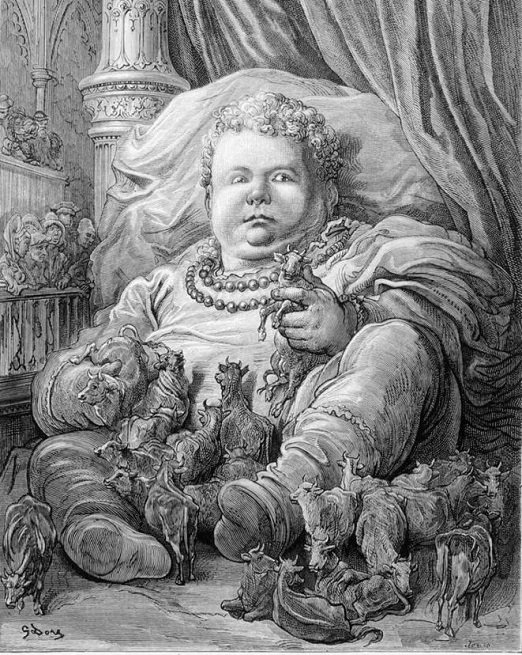Rable and his book "Pantagrüel and Gargantua" / part 4/
The rhetorical Rable 's rich and colorful speech penetrates everywhere - the earth and the sea, the mountains and the rivers, the arteries and the skeleton, the Scripture and the intellect, the brain and the skull, the wellbeing and the reproductive instinct, the stomach and the genitals. His word resembles a very agile and flexible genius who fits nicely into every body and intellect, turns into flesh and water, has no restraint to roam around the offal and faeces, enters the censored by the Church areas of human reproduction and sexual delight. It cleanses the minds of the people of the Middle Ages to the Renaissance from the theological notion of the world as a harmonious whole, the creation of the inexhaustible power of God, and as if it brings them back to the pagan myth of Pan, whose sensual and lively desire drives the world towards fruitful union and beautiful harmony.
In Preface to First Book, Rable warns his readers not to conjecture that after his books have been labeled "fun titles," there are only hooligans, merry fables, and false lyrics. He advises them to continue to search under "pretty fun things," "a higher sense in what seemed to you to be devoid of depth." Through the rhetorical question, "Have you watched a dog that unexpectedly finds a fat bone?", The French novelist returns his subjects to the image of "the wisest animal in the world," according to Plato's famous "About the State": surely you have noticed how benevolent it is for this bones, how keenly it keeps it, how it bites it, how passion it crunch, how delight it sucks. What instinct forces him to do that? What is it and what does it want? Nothing but a little bone marrow. Indeed this "little" is sweeter than anything else, because ... the brain is the most perfect food that nature offers us. Rable views the world of readers as a whole, in which two polemic communities are formed - those who, like monkeys, are scrambling their heads in front of the reader's deeper meaning, and those who, by the example of the wisest animal of the world"/ suck down the deep meaning of the work inside and make it a masterpiece. The liveliness and inexhaustible Invincibility of Pan seemed to inspire the witches, the friends of Gargantua, who had gathered in a cup while waiting for his child to come to light. In his sober whim of speech, the novelist Rable often builds impressive arrays of praises, wishes, cheers, curses, swearing, and so on.
The rapture of the novelist Rable over the theological censorship about the physiology of the procession is numerous and not always funny ironic. The little giant Gargantua "is born in an extraordinary way" after his mother, Gargamella, swallows "two barrels and six pots of intestines." A "witch-maker gave Gargamella some terrible clamping device, which made her ring muscles so tight and lost elasticity that you / it was scary to think, and you could not stretch them with teeth": "This trouble led to an excessive enlargement of the placenta, the child slipped out of it, slid into the vein between the diaphragm and the shoulders where it split, curved aside, and popped out of the left ear ... Rable "assures" that Gargantua's birth is not so strange after Bacchus comes out of Jupiter's thigh, Minerva is born of his brain and comes out of his ear (Jupiter)." And how much more would you be wondering and laughing, the novelist will calm down if I put you all the head of Pliny that talks about strange and unnatural races. But I'm not such a brazen liar like him. Another compassionate ambition of the man of the Renaissance, after satisfying the humor, is his desire to be well transformed, to look good, to say something definite to others with his appearance, his garments. Father Gargantua orders his son "to make clothes in the family colors - white and blue" (I book, VIII). "The clothes were cut and sewn according to the requirements of the fashion at that time ... For the shirt went nine hundred shepherd canvas canvas and more two hundred for the square wedges under the armpits ... For the elephant eight hundred and thirty centimeters white satin, and for its linings one thousand and five hundred and nine and a half canine skins ... The trousers went one thousand one hundred and five cubits and a third white woolen cloth. They were shaped like columns and with crevices and openings in the rear to prevent the kidneys from reheating ... Sixteen centimeters and a quarter of the same cloth went to the cube. It was sewn in the shape of a rainbow, gracefully tucked with two beautiful gold-plated balls with enamel hooks, each of which had an emerald as big as an orange ..
The educational regime that the new gentleman-gynecologist Panocrat imposes on his native when he teaches in Paris, Sorbonne, is a parody of the adoption of the warrior's and code by the characters of the Late Middle Ages novels of the Knights. Gargantua is trained to serve artificially . Faced with the ridiculous diligence to train his private pupil on a par with it, Pannakrat introduces him daily in a parable of the Holy Scriptures, instructs him how to keep himself at the table, how to clean his teeth "with a slice of sapwood", teaches him to play " a spaniel, a harp, a German flute with nine flaps, a viola and a trombone. "

I have find the photo very cute. Thanks for sharing this art and culture.